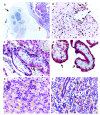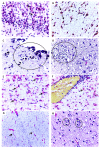Zika Virus Epidemic in Brazil. II. Post-Mortem Analyses of Neonates with Microcephaly, Stillbirths, and Miscarriage
- PMID: 30487475
- PMCID: PMC6306831
- DOI: 10.3390/jcm7120496
Zika Virus Epidemic in Brazil. II. Post-Mortem Analyses of Neonates with Microcephaly, Stillbirths, and Miscarriage
Abstract
Introduction: The recent Zika virus(ZIKV) epidemic in Brazil was characterized by a range of different clinical presentations, particularly microcephaly, Guillain-Barré syndrome, and death. In this context, we determined the causal relationship between fatal microcephaly cases and ZIKV infection.
Methods: Twelve fatal cases of neonates, whose mothers were infected with ZIKV during pregnancy, were examined; cases included nine neonatal deaths due to microcephaly, one miscarriage, and two stillbirths. Tissue samples were obtained from all cases at necropsy and were submitted for virological investigation (RT-qPCR and virus isolation) and/or histopathology (hematoxylin and eosin staining) and immunohistochemical assay for the detection of ZIKV antigens.
Results: ZIKV antigens and/or ZIKV RNA were detected in tissue samples of all 12 cases examined. ZIKV was recovered in one case. Results of the virological and immunohistochemical analyses, as well as the anatomic abnormalities and histopathologic changes observed at necropsy on the 12 fatal cases, are presented.
Conclusions: Data from these 12 cases provide strong evidence of the causal relationship between ZIKV and congenital disease in fetuses of women who were infected with the virus during pregnancy.
Keywords: ZIKV RNA; Zika virus; and ZIKV antigen; congenital syndrome; microcephaly.
Conflict of interest statement
The authors declare no conflict of interest.
Figures



Similar articles
-
Zika virus epidemic in Brazil. I. Fatal disease in adults: Clinical and laboratorial aspects.J Clin Virol. 2016 Dec;85:56-64. doi: 10.1016/j.jcv.2016.10.024. Epub 2016 Nov 5. J Clin Virol. 2016. PMID: 27835759 Free PMC article.
-
Progressive lesions of central nervous system in microcephalic fetuses with suspected congenital Zika virus syndrome.Ultrasound Obstet Gynecol. 2017 Dec;50(6):717-722. doi: 10.1002/uog.17303. Epub 2017 Nov 8. Ultrasound Obstet Gynecol. 2017. PMID: 27644020
-
Perinatal analyses of Zika- and dengue virus-specific neutralizing antibodies: A microcephaly case-control study in an area of high dengue endemicity in Brazil.PLoS Negl Trop Dis. 2019 Mar 11;13(3):e0007246. doi: 10.1371/journal.pntd.0007246. eCollection 2019 Mar. PLoS Negl Trop Dis. 2019. PMID: 30856223 Free PMC article.
-
Zika infection and the development of neurological defects.Cell Microbiol. 2017 Jun;19(6). doi: 10.1111/cmi.12744. Epub 2017 May 3. Cell Microbiol. 2017. PMID: 28370966 Review.
-
Zika virus infection as a cause of congenital brain abnormalities and Guillain-Barré syndrome: From systematic review to living systematic review.F1000Res. 2018 Feb 15;7:196. doi: 10.12688/f1000research.13704.1. eCollection 2018. F1000Res. 2018. PMID: 30631437 Free PMC article.
Cited by
-
Comparative Analysis of Human Hepatic Lesions in Dengue, Yellow Fever, and Chikungunya: Revisiting Histopathological Changes in the Light of Modern Knowledge of Cell Pathology.Pathogens. 2023 May 4;12(5):680. doi: 10.3390/pathogens12050680. Pathogens. 2023. PMID: 37242350 Free PMC article.
-
Investigation on Spontaneous Abortion and Human Papillomavirus Infection.Vaccines (Basel). 2020 Aug 25;8(3):473. doi: 10.3390/vaccines8030473. Vaccines (Basel). 2020. PMID: 32854278 Free PMC article.
-
Three-Year Clinical Follow-Up of Children Intrauterine Exposed to Zika Virus.Viruses. 2021 Mar 22;13(3):523. doi: 10.3390/v13030523. Viruses. 2021. PMID: 33810110 Free PMC article.
-
Prenatal disorders and congenital Zika syndrome in squirrel monkeys.Sci Rep. 2021 Jan 29;11(1):2698. doi: 10.1038/s41598-021-82028-3. Sci Rep. 2021. PMID: 33514824 Free PMC article.
-
The Scientific Response to Zika Virus.J Clin Med. 2019 Mar 15;8(3):369. doi: 10.3390/jcm8030369. J Clin Med. 2019. PMID: 30884762 Free PMC article.
References
-
- Oehler E., Watrin L., Larre P., Leparc-Goffart I., Lastere S., Valour F., Baudouin L., Mallet H., Musso D., Ghawche F. Zika virus infection complicated by Guillain-Barre syndrome—Case report, French Polynesia, December 2013. Euro Surveill. 2014;19:7–9. doi: 10.2807/1560-7917.ES2014.19.9.20720. - DOI - PubMed
-
- Pan American Health Organization (PAHO)/World Health Organization (WHO) Zika—Epidemiological Update, 25 August 2017. PAHO/WHO; Washington, DC, USA: 2017.
Grants and funding
LinkOut - more resources
Full Text Sources

